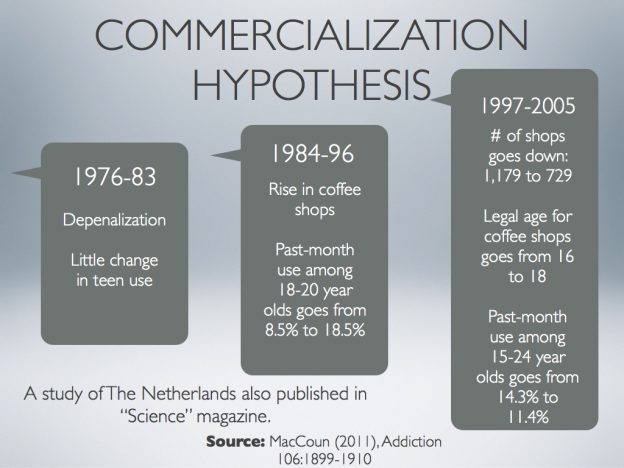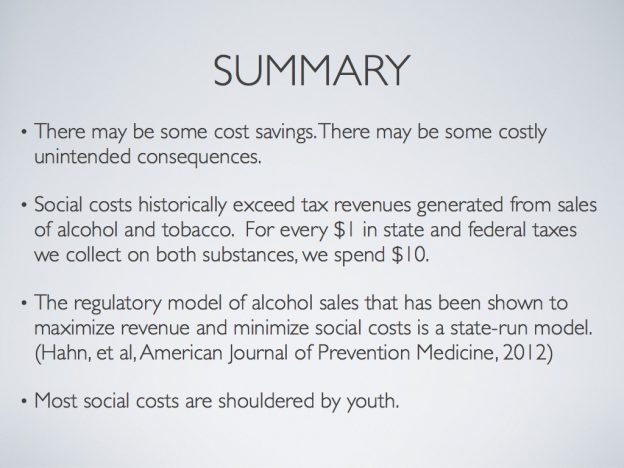Prohibitionist Makes the Case for Marijuana Legalization
As marijuana was becoming legal in Colorado, one man loudly campaigned against it. His name is Dr. Christian Thurstone and he is one of the Denver area’s largest rehab entrepreneurs. He makes money when people pay for his rehab services, whether that’s the occasional heroin addict in serious need of mental and physical rehabilitation or… oh, who am I kidding? Dr. Chris makes his money when young people are caught with weed and forced by their parents, schools, or the criminal justice system to get “marijuana rehab”.
I’d tell you what proportion those marijuana users make of Dr. Chris’s business, but he is notoriously shy about releasing any statistics from his practice unless he can make a prohibition point with them. For instance, he once noted how kids coming into his rehab were testing positive for over 500 nanograms of THC! I thought that wasn’t true, since the “legal limit” for “stoned driving” is 5 nanograms of active THC in the bloodstream and immediately after toking THC spikes at about 100 nanograms. That college kid who jumped off the balcony after eating a medicated cookie only turned up with 7.2 nanograms in his autopsy. So I wrote to ask if he really meant THC-COOH, the inactive marijuana metabolite? Nope, he insisted, they tested for active THC, making me wonder how those teenagers were even able to walk, much less sign in to a rehab for their “marijuana addiction”?
But I can tell you what the statistics are for most of the drug rehabs in the United States as of 2011. When it comes to those placed in rehab for marijuana alone, over half (53%) of the admissions are forced by the criminal justice system and another quarter (25.5%) are referrals from schools and employers over failed piss tests. Only about 15 percent of admissions were cannabis consumers self-admitting to treat what they considered to be problem use.
Now, compare that to Dr. Chris’s other customers, the people who use drugs other than marijuana. Criminal justice only forced a third of them (33.1%) to rehab and another ninth (11.1%) were sent in for failing work or school drug tests. Nearly two out of five drug users (38.8%) referred themselves to rehab when they felt they had a drug problem. Then understand that when it comes to the primary or secondary substance used by a rehabber, among five users there are about 2 users there for drugs (42%), 2 there for alcohol (37%), and 1 there for marijuana (21%), and among those marijuana smokers, more than half used pot less than once a week and over a third didn’t use pot for a whole month before rehab (boy, that’s some addiction if you can kick it cold turkey for a month without rehab!)
So think it out… if you’re in the business of rehab, among 100 customers, you’ll have about 40 “druggies”, 40 “drunks”, and 20 “potheads”. Of those 20 “potheads”, about 10 of them were forced there by a court and another 5 were forced there by a failed drug test at school or work. Only 5 “potheads” came to your business because they wanted your service. Under legalization, at least half your marijuana customers, representing 10% of your clients, are no longer compelled by arrests and courts to patronize your establishment.
Rehabitionists like Dr. Christian Thurstone and Dr. Kevin Sabet know this is a powerful indictment of the scam of drug courts and marijuana rehabs, so they always pretend like legalization isn’t hurting their bottom line. They’ll offer some excuse about how if they were profit-driven, they’d support legalization since it will create so many more marijuana addicts to rehab. But when they’re losing half their marijuana customers to legalization and only half again as many self-admit to rehab for marijuana, wouldn’t marijuana use have to increase by double to quadruple for them to just break even?
Poor Dr. Chris is so befuddled by the majority of Coloradoans who disagree with him about marijuana’s legality that as he travels from city to city to warn about the dangers of the devil’s weed, he inadvertently makes the case for legalization. Dr. Chris features on his website some “neuroimages” (on Earth, we call them “PowerPoint Slides”) on the “Social Costs of Marijuana”. Here’s one about the Dutch marijuana coffee shops that I don’t think he thought through:

In the slide, he points out that from 1976-83, the Dutch depenalized marijuana consumption. That’s not entirely accurate; the Dutch just made it such a low priority that no adult was harassed by police over personal marijuana use. It’s still technically illegal. But, as Dr. Chris points out, under that policy, there was “little change in teen use.” So, does Dr. Chris support a policy of tolerance of adult marijuana use?
Next, Dr. Chris points out how the coffee shops came into existence from 1984-96 and there is a huge rise in past-month use by people aged 18-20. This would be a damning statistic showing how a 21-year-old age limit, like in Colorado, led to a mass increase in use by underaged tokers… except for Dr. Chris’s third graphic, which shows how from 1984-96, the legal age of entry to a coffee shop was 16 years old. So use by 18-20 year olds increased when it was legal for 16, 17, 18, 19, and 20 year olds to get into a coffee shop and smoke pot? The hell you say! Then, from 1997-2005 when the age is raised to 18, there’s a drop in use by those aged 15-24 (where’s that 18-20 year old data)? Why, Dr. Chris makes it sound as if decriminalization didn’t raise teen pot use rates and raising the legal age worked to deter underage use.
Then there’s Dr. Chris’s summary slide:

There’s that Sabet Conjecture, the hypothesis that since alcohol and tobacco cost $10 to society for every $1 they bring in for tax revenue, marijuana would be just as bad. Let’s see, recreational marijuana taxes have brought forth $6 million in new revenue, so Dr. Chris must expect us to believe that it has cost Colorado $60 million in social costs. Also, offset the police and court costs we’re not spending now that the average number of marijuana arrests per month (all charges) has dropped from about 800 a month to 100 a month.
So where’s that $60 million in social cost, Dr. Chris? Marijuana use rates have remained steady at about 8 percent. Crashes and fatalities on the roads have declined. Kids kicked out of school for marijuana use represent 0.04% of the Colorado student population. Travel interest in Denver is up well over last years’ numbers. Thousands of people attended a Cannabis Job Fair where hundreds of new jobs in the industry were being filled by people who will be contributing taxpayers. Where’s the $60 million in costs – new costs that weren’t already being paid when that same 8 percent of Coloradoans were illegal tokers?
It’s fun watching the businesses beholden to marijuana prohibition screeching their cries of extinction. About one hundred years ago, I’m sure buggy whip makers, stagecoach operators, and saddle manufacturers made the same kind of noises… only without any “neuroimages”.






